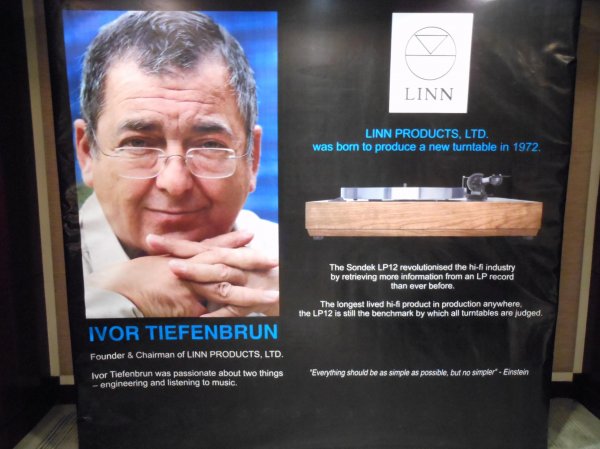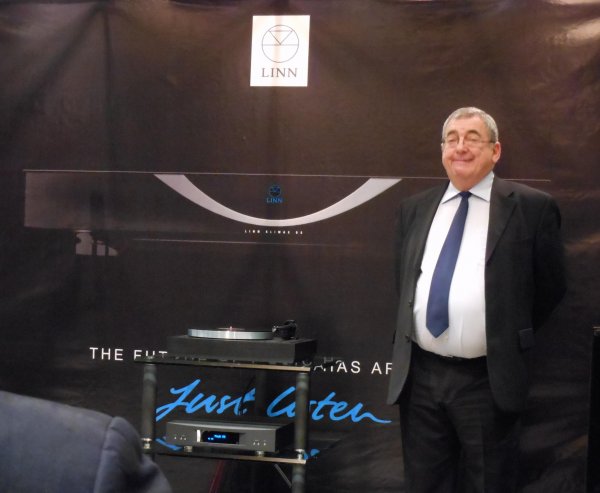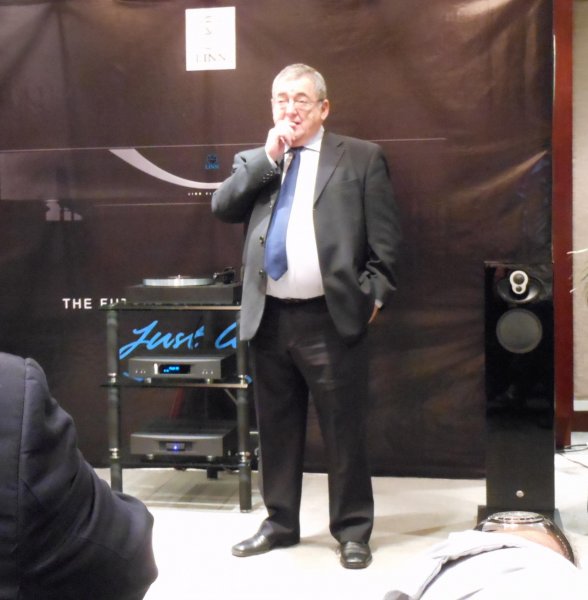Ivor Tiefenbrun is a genius. I don’t want to enumerate all of his contributions to our world of hi fi. I want to concentrate on one. It is a revolutionary idea; a brand new idea; never was seen before by the world. It seems like it is lost, meaning that, while we all use it all the time, the origin of the idea is lost and unappreciated. I want to correct this. I’ll explain, at the end of this essay, its significance in our modern hi fi systems. And like many great ideas, it is simple. All you need is the ability to see around corners. Ivor has this rare ability. You should understand that I’m not a “Linnie”. I’ve never owned a Linn product though I probably should have. Rather, I’m an appreciator of great ideas. They are not all that common.
Background
Turntables in the early seventies had achieved an impressive level of sophistication. All the classic performance indicators had been attacked by the designers and greatly improved; to the point where further improvements were becoming difficult. The prevalent view was all a turntable had to do is spin a record with speed accurately, quietly, and with isolation from its surroundings. All they had to do was sit there and do their job, unobserved, like a water heater. It was thought that the most important element in a hi fi system were speakers. No one expected a revolution in turntable design.
Ivor did not share this view. He thought that the most important element in a system was the signal source; the turntable, arm, and cartridge. This was a very controversial thought for which he was criticized. So he set out to prove his point. Thus, his Demonstration about which I am writing.
The Demonstration
Ivor, in his own inimitable way, pronounced that a turntable had a sound. “What”, the world exclaimed? Loudly it was pronounced that all a turntable had to be was unobserved, silent. What do mean “a sound”? Ivor explained that turntables had a sonic signature. This was completely beyond what people could relate to. “What are you talking about? Prove it.” He did.
The Demonstration Ivor invented was as simple as it was profound. It consisted of a good modern turntable, say a current production Thorens TD125, two good tone arms and cartridges (what kind doesn’t matter), an oscilloscope with dual channels, and a test record. The test record had a series of transients impressed at normal recorded levels. The interval between the transient bursts was one burst per 360 degrees of revolution. The turntable was configured with two tone arms placed such that the stylus tips were 180 degrees apart when they were playing the record. The scopes monitored the output of the arms, one arm per channel. The record was played by both arms simultaneously.
Because of the burst timing only one tone arm at a time had a groove signal to monitor. They would alternate as the burst passed first one tone arm and then the other. What was seen on the scopes was definitive. By the knowledge of the day, you would expect first one tone arm to produce a burst then half a revolution later the other would produce the burst as displayed on the scope channels. Simple. But that’s not all that happened. A short time after, say, the left tone arm produced the burst, the right tone arm would show a kind of ghost of the transient, delayed. Then ½ a revolution later the right tone arm produced the burst and the left tone arm showed a delayed ghost of the transient. The ghosts were not all that small. They were obvious. Where were the ghosts coming from? They were not on the record. This is the key point of the demonstration.
There was no other conclusion possible. The ghosts were a result of the force supplied by the record groove to move the stylus and the reaction to that force transferring energy to the vinyl. It’s an action/reaction situation. The reaction caused a pressure wave to travel across the record, through the vinyl, to be detected by the other cartridge and show up as a ghost of the original but delayed by the traverse time across the vinyl.
Then things got really interesting. The ghost wave encountered the edge of the record which represented a huge mechanical impedance change from the vinyl to open air. When this happens in either mechanical systems or electrical systems the energy is not absorbed but is reflected with little loss. Now the reflected wave re-traversed the record back to the original stylus where it was added to the original transient and displayed as a second generation ghost, delayed and reduced in amplitude.
But things do not end there. The ghost is now traveling in all directions in the vinyl hitting the record edges at various angles and being reflected in a variety of directions and time delays until it finally runs out of energy. All this is shown on the scope display. The result is the original transient burst, which would be expected to be clean, is, in fact added to the ghosts and is smeared. In other words a turntable signature is created. Ah Ivor, you are magnificent!
Just imagine how a real instrumental recording would behave with its huge variety of sounds and transients. A smeared mess (my words)!! The image of a record alive with ghost images bouncing around with no sensible time relationship to the original transients comes to mind. Indeed, a turntable has a signature. Are you convinced? Others were.
The Fall Out
It took a while for the significance of Ivor’s demonstration to sink in. One result is people started to pay attention to the LP12. It flat out sounded better than the competition and one of the reasons was the lack of signature and unsmeared transients. Ivor, quite simply, had a better idea, a new idea, and showed the world.
The world of turntable designers was turned upside down. Overnight their beautiful creations were obsolete. This was nothing to cry over – just a new challenge. Out came the drafting boards, materials manuals, and slide rules (yes, personal calculators were still a bit in the future) and the revolution started.
The way the problem of reflected energy was attacked was to figure out a way of absorbing the ghost energy before they could be reflected back to the stylus. New turntable designs started to show up. It’s interesting, but I don’t think these ideas were adopted by the Japanese makers. New manufacturers started to appear with designs entirely devoted to the ghost problem. Older makers, such as Thorens, ignored the revolution and fell by the wayside. Their stuff, good as it was, was still traditional and not good enough.
Some of the new makers exceeded the LP12 with very advanced energy absorbing technologies. Sota brought out their line of vacuum turntables with energy absorbing platters which were very effective. Center clamps, which were never part of the arsenal before Ivor, became de rigor with brands such as VPI, Oracle, and many others. The revolution is now complete all thanks to Ivor and his new idea.
So today, as we gaze at our modern turntable wonders, we can thank Ivor and his around the corner thinking for our incredible sound.
Sparky
Background
Turntables in the early seventies had achieved an impressive level of sophistication. All the classic performance indicators had been attacked by the designers and greatly improved; to the point where further improvements were becoming difficult. The prevalent view was all a turntable had to do is spin a record with speed accurately, quietly, and with isolation from its surroundings. All they had to do was sit there and do their job, unobserved, like a water heater. It was thought that the most important element in a hi fi system were speakers. No one expected a revolution in turntable design.
Ivor did not share this view. He thought that the most important element in a system was the signal source; the turntable, arm, and cartridge. This was a very controversial thought for which he was criticized. So he set out to prove his point. Thus, his Demonstration about which I am writing.
The Demonstration
Ivor, in his own inimitable way, pronounced that a turntable had a sound. “What”, the world exclaimed? Loudly it was pronounced that all a turntable had to be was unobserved, silent. What do mean “a sound”? Ivor explained that turntables had a sonic signature. This was completely beyond what people could relate to. “What are you talking about? Prove it.” He did.
The Demonstration Ivor invented was as simple as it was profound. It consisted of a good modern turntable, say a current production Thorens TD125, two good tone arms and cartridges (what kind doesn’t matter), an oscilloscope with dual channels, and a test record. The test record had a series of transients impressed at normal recorded levels. The interval between the transient bursts was one burst per 360 degrees of revolution. The turntable was configured with two tone arms placed such that the stylus tips were 180 degrees apart when they were playing the record. The scopes monitored the output of the arms, one arm per channel. The record was played by both arms simultaneously.
Because of the burst timing only one tone arm at a time had a groove signal to monitor. They would alternate as the burst passed first one tone arm and then the other. What was seen on the scopes was definitive. By the knowledge of the day, you would expect first one tone arm to produce a burst then half a revolution later the other would produce the burst as displayed on the scope channels. Simple. But that’s not all that happened. A short time after, say, the left tone arm produced the burst, the right tone arm would show a kind of ghost of the transient, delayed. Then ½ a revolution later the right tone arm produced the burst and the left tone arm showed a delayed ghost of the transient. The ghosts were not all that small. They were obvious. Where were the ghosts coming from? They were not on the record. This is the key point of the demonstration.
There was no other conclusion possible. The ghosts were a result of the force supplied by the record groove to move the stylus and the reaction to that force transferring energy to the vinyl. It’s an action/reaction situation. The reaction caused a pressure wave to travel across the record, through the vinyl, to be detected by the other cartridge and show up as a ghost of the original but delayed by the traverse time across the vinyl.
Then things got really interesting. The ghost wave encountered the edge of the record which represented a huge mechanical impedance change from the vinyl to open air. When this happens in either mechanical systems or electrical systems the energy is not absorbed but is reflected with little loss. Now the reflected wave re-traversed the record back to the original stylus where it was added to the original transient and displayed as a second generation ghost, delayed and reduced in amplitude.
But things do not end there. The ghost is now traveling in all directions in the vinyl hitting the record edges at various angles and being reflected in a variety of directions and time delays until it finally runs out of energy. All this is shown on the scope display. The result is the original transient burst, which would be expected to be clean, is, in fact added to the ghosts and is smeared. In other words a turntable signature is created. Ah Ivor, you are magnificent!
Just imagine how a real instrumental recording would behave with its huge variety of sounds and transients. A smeared mess (my words)!! The image of a record alive with ghost images bouncing around with no sensible time relationship to the original transients comes to mind. Indeed, a turntable has a signature. Are you convinced? Others were.
The Fall Out
It took a while for the significance of Ivor’s demonstration to sink in. One result is people started to pay attention to the LP12. It flat out sounded better than the competition and one of the reasons was the lack of signature and unsmeared transients. Ivor, quite simply, had a better idea, a new idea, and showed the world.
The world of turntable designers was turned upside down. Overnight their beautiful creations were obsolete. This was nothing to cry over – just a new challenge. Out came the drafting boards, materials manuals, and slide rules (yes, personal calculators were still a bit in the future) and the revolution started.
The way the problem of reflected energy was attacked was to figure out a way of absorbing the ghost energy before they could be reflected back to the stylus. New turntable designs started to show up. It’s interesting, but I don’t think these ideas were adopted by the Japanese makers. New manufacturers started to appear with designs entirely devoted to the ghost problem. Older makers, such as Thorens, ignored the revolution and fell by the wayside. Their stuff, good as it was, was still traditional and not good enough.
Some of the new makers exceeded the LP12 with very advanced energy absorbing technologies. Sota brought out their line of vacuum turntables with energy absorbing platters which were very effective. Center clamps, which were never part of the arsenal before Ivor, became de rigor with brands such as VPI, Oracle, and many others. The revolution is now complete all thanks to Ivor and his new idea.
So today, as we gaze at our modern turntable wonders, we can thank Ivor and his around the corner thinking for our incredible sound.
Sparky
Last edited:







